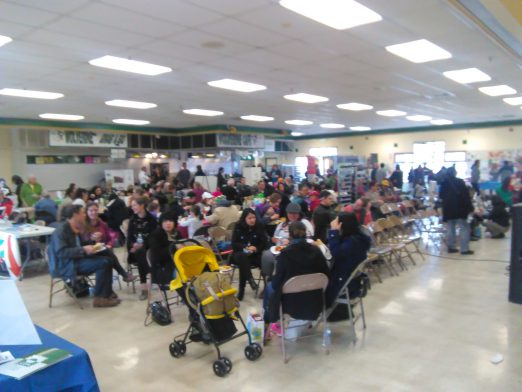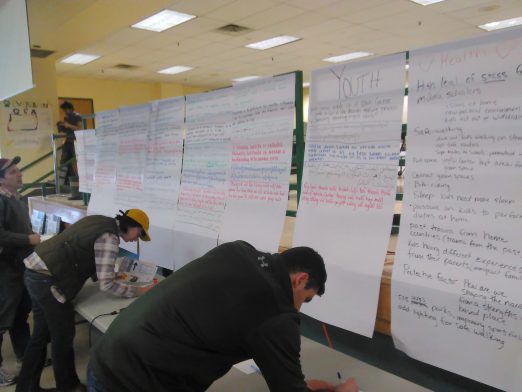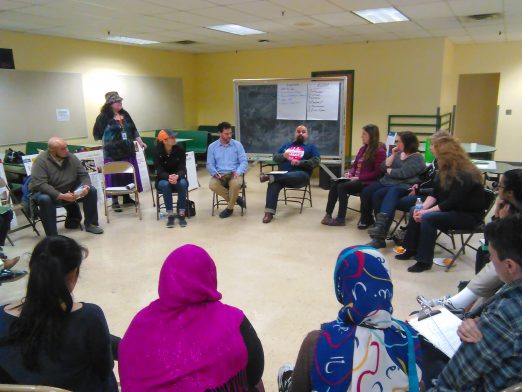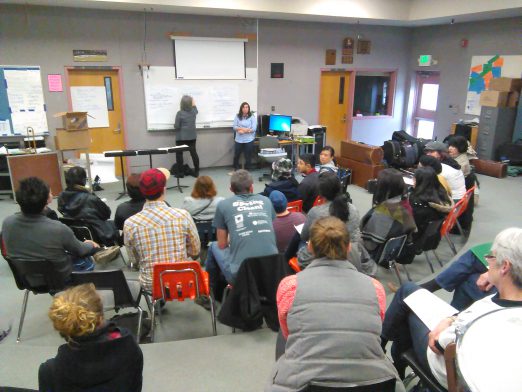By Tracy Record
White Center Now editor
While the announcement of last night’s North Highline Unincorporated Area Council meeting highlighted a briefing from North Highline’s fire chief, an unannounced speaker – a former NHUAC board member who is now an encampment resident – was also a highlight. Here’s how the meeting unfolded:
NORTH HIGHLINE FIRE DISTRICT: Mike Marrs, chief for 4 years in addition to being chief of Burien Fire District 2, was there primarily to explain how legislation in Olympia could be a threat to some of the money the district needs to operate – funding it secured just two years ago, with a voter-approved measure, via the “benefit charge.”
First, Marrs detailed the district’s many-faceted 75-year history, changed along the way by various annexations, districts, and alliances.
The history included how the Fire District gets funding – primarily through property taxes – and that meant a big drop during the recession almost a decade ago: “20, 30 percent.” NHFD “made some hard choices” and that included the leadership consolidation. District 2 pays NHFD to serve North Burien; NHFD pays District 2 for Marrs to be its chief as well as theirs.
“It was supposed to be a Band-Aid,” he recalled, “probably a short-term fix, get us through the economic difficulties,” and annexation by either Burien or Seattle seemed likely to happen relatively quickly. But then came the 2012 vote in North Highline “Area Y” rejecting Burien, and the “Band-Aid” has had to stay on.
In property taxes, “we levy up to $1.50 for $1,000 assessed value” for fire/EMS services, Marrs said, but “that number wasn’t enough to continue to field (the staffing they had).” That led to the Fire Benefit Charge, “instead of levying $1.50 per $1,000, you reduce your tax to $1.00, and then there’s a formula for (that charge).” It’s not a fee for service, but a charge for everyone to pay to benefit from having the service available.
The formula involves how much water would have to be put on what’s on your property if there was a fully involved fire. (More than 5,500 parcels are in the area.) The vote authorizing it was in 2014; it was applied in 2015; it has to be re-authorized by voters in 2020.
“The one thing that really resonated with the commissioners was that by using the Fire Benefit Charge, low-income, tax-exempt housing would have to pay it too. …The amount of (that) in the NHFD is dramatically higher than other places in the county. You have a lot of parcels that never paid any property taxes – the sole funding for the fire district – (including) multifamily properties that … get a high benefit from (the service). … The board felt over the years that there was a real inequity (in the 3 1/2-square-mile district)” before the charge was implemented.
100 percent of the district’s revenue used to be from property taxes; now it’s 80 percent taxes, 20 percent benefit charge. Some of the tax-exempt-property owners, though, he said, feel they shouldn’t have to pay, “because all of their money should go into … housing.”
For the past two years in Olympia, Marrs continued, there’s been legislation related to this, after fire departments elsewhere formed big regional “fire authorities” and implemented benefit charges.
The benefit charge required a 60 percent supermajority of voters to pass, but will only require a 50 percent approval for reauthorization. The regional authorities, however, need a 60 percent to reauthorize, and have been seeking to have that reduced to a simple majority.
And that’s where the trouble erupted. The entities that don’t want to pay the benefit charges, Marrs explained, have jumped onto the legislation, seeking exemptions from those charges in all sizes of fire districts/authorities. Marrs said he had been to Olympia to testify this past Tuesday. He tried to explain that larger districts have more property owners and so if they have to pick up the slack, it’s not as much of a hardship. $208,000 is the median price here; $260,000 is the median in Kent; $670,000 in Woodinville, he noted. Other areas also have bigger commercial bases to draw on, for funding.
Without the charge, Marrs stressed, there’s a real inequity in terms of properties being supported by so many others. They are currently opposing the bill, and seeking to have the proposed benefit-charge exemption removed. “We’re only asking them to contribute to the 20 percent of the budget,” not the rest of it, he reiterated. But, he said, “I think we have an uphill battle.”
Asked if the new mixed-use development on the former supermarket site in Top Hat will be tax-exempt, Marrs said he believes it will be. (We’ll follow up on that.) NHUAC vice president Barbara Dobkin pointed out that North Highline has double the poverty rate of King County in general – 25 percent, compared to 11 percent.
“How underfunded would we be without that money?” asked NHUAC board member Roslyn Hyde.
The charge could be raised and spread among the remaining taxpayers, Marrs said. “We know what King County Housing pays us … it’s all the others, we don’t know whether they would qualify,” such as the Coronado Springs apartment building, which “is a huge contributor now.” KCHA pays about $50,000 a year via the benefit charge, so for just that example, NHFD could just “go without” that money,” or raise what it charges among the remaining payers.
The benefit charge, he clarified, is a “more equitable way to generate money for the fire department” because, for example, a 2,000-square-foot house takes the same amount of firefighting whether it’s a highly valued view property or something of much less value. (In case you’re wondering, Marrs didn’t have the exact amount that a 2,000-sf house is charged, but said it was in the $150 vicinity.)
North Highline and Burien District 2 are somewhat isolated, he explained in answering another question – they don’t have a lot of mutual-aid resources (they’re still trying to improve how that works with Seattle, for example, he said).
So what can be done? asked NHUAC board member Rich Leibfried.
“We might ask people to write their representatives,” Marrs said. NHUAC president Liz Giba expressed frustration that the housing operators have been working on this for a long time but didn’t even see fit to bring it up with district/community leaders.
The House bill is HB 1467; the Senate bill is SB 5364. (Looking at the HB 1467 page on the Legislature’s website, we note that local State Rep. Joe Fitzgibbon is a sponsor.)
If communicating with legislators, you would ask them “to remove the low-income-housing exemptions from the bills.” (The main part of the bill – getting the fire authorities’ reauthorization level to 50 percent – is not something NHFD is opposing.)
Asked about NHFD’s budget this year, Chief Marrs said it includes about $1.2 million from the benefit charge, $2.2 million from the Burien contract, and ~$2 million from property taxes. They’re “behind on engine replacement”; their budget also goes to thermal-imaging cameras, backup “bunker gear” to better =protect firefighters from the high risk of cancer; body armor when they’re dealing with scenes where they’re treating victims of violence; washer-dryer equipment that has to be dedicated to separate uses (fires and violence scenes). Their calls are split roughly 80 percent medical calls, 20 percent fires and other emergencies.
SIDE NOTE: Marrs also mentioned the cardiac-survival rate of Medic One, once “best in the world” at 27 percent, with a leader who took the rate above 60 percent within about a decade. Factors include the highest citizen-CPR training, cardiac defibrillation by responders, and excellent care at local medical centers. “Your chances of walking out of the hospital alive after suffering a cardiac event in Seattle-King County is off the charts.”
(P.S. At the start of the Fire District discussion, NHUAC president Giba reminded all first that she also is a member of the NHFD Board.)
HOMELESSNESS-RELATED TOPICS: These were all discussed in the final segment of the meeting.
First, NHUAC board member Hyde recapped last week’s meeting at which the new plan for the White Center shelter was officially announced (WCN coverage here), with Mary’s Place planning to open a family shelter, starting with about 30 people, at 8th/108th, likely on or by March 1st. She said a “wish list” of needed items would be forthcoming once there’s somewhere to store such items. Pack ‘n’ Plays and twin bedsheets are among the most-needed items, she noted. You can also apply to volunteer, via a link on the Mary’s Place website. And she reminded all of the February 11th work party.
Second, Camp Second Chance – Dobkin said she was at last night’s City of Seattle-operated meeting about what has been an unauthorized encampment since last summer on Myers Way (WCN coverage here) and is about to be made by the City of Seattle into an authorized encampment. Among other things, she said it was disappointing that no one from King County had been invited to the meeting. Leibfried noted that most of the concerns voiced were about campers outside CSC.
Then a camp resident – former NHUAC board member Patrick Mosley, who served on the board 2010-2012 – came up to the podium.
Mosley said he became homeless after losing his spouse and his home. He had been living in his truck – until an exhaust leak. He first went to a shelter in Fremont and discovered some things about it that didn’t work …including issues with a longtime encampment operator (SHARE). Then he went back to California for a while, and, when returning here to visit his children, he learned about the splinter group that had formed Camp Second Chance.
Mosley talked about the camp’s self-sufficiency and quest for 501(c)(3) status, and an eventual plan to have it become a business. “SHARE isn’t necessarily happy that this encampment is there” because of it being sanctioned, he said. He said he’s been at the camp for about three months, and that it’s a “model camp – the first time that people in this situation have a chance to make a difference … in this situation.”
He talked about a friend who committed a crime “during a few minutes of a bad mistake” who will likely never be able to get a job again. He said the camp works to help people get and stay sober, is working to help people learn skills such as gardening, is working to set up a system to get people
“It may not affect you now but it might in the future … so it’s best to set up a relationship before you (possibly) need it.”
Giba asked him what he feels about the people living outside the camp. “What do they mean to you, living there?” He said he has spoken to many of them whom he sees daily. “It’s a similar situation but different.” One man for example has mental issues. He explained that everyone at the camp has to chip in $20/month to help pay for things such as propane. Substance abusers, for example, aren’t interested in doing that. “There are a lot of drug, and drug issues, over there … but there are everywhere.” He also noted that not all the trash you see in the area was left “by the homeless people” – some is dumped by people from elsewhere. He said there are a variety of difficult circumstances, such as people going through the “revolving door” of prison/jail, and
An attendee asked about people being required to take housing if it’s offered/available. “Part of the contract with the city is that if they offer it, we can’t refuse it.”
He said would-be campers soon will have to pass a background check to see if they are a sex offender, to sign that they understand the camp’s rules, that they attend the Monday meetings.
Polly Trout from Patacara Community Services, announced last night as the camp’s operator, said that the camp will continue to be self-governing, but that her organization “We’re enrolling everyone in the new King County Coordinated Entry …but the reality is that there’s not enough housing for everyone.” She said people are prioritized, such as severely disabled people, youth, and families. About half the CSC residents are working, he said, but don’t fit into those prioritized categories. “There are some people on disability who are on waitlists,” for example, or awaiting disability-payment eligibility.
Trout said they’d been asked how people can help the camp and its residents. “If you need a handyperson or someone to mow your lawn, you might think about coming to the camp.” She said she would not recommend someone unless she could recommend them wholeheartedly. She mentioned a couple who had lived in the camp for a while and have just moved into a rental room at a house of a friend of Trout’s.
She was asked for a little more background on herself; she’s been working with Seattle-area homeless people for 15 years, 12 of those with youth in the U-District via Seattle Education Access. She formed Patacara with an interest in something more intergenerational.
From the audience, attendee Ben Calot contended that “there are jobs out there for everyone”; he was an employer and had an employee “who smoked crack in the bathroom every day on shift.”
10 percent of CSC’s residents have been moving into housing every month, Trout said. Mosley said it has 15 residents right now, and that they’re likely to grow to 70. And the camp will be voting on potential use of “tiny houses,” as a result of what city reps said at last night’s meeting. They will consider building tiny houses themselves; other encampments generally have tiny houses built by donors. “The city has authorized us to have 50 tents and/or tiny houses,” Trout added.
What happens after two years? she was asked. They will have to find somewhere to move to, she said.
Next speaker, area resident Pat Lemoine – who said at the previous night’s meeting, and reiterated at this one, that he has a “plan to get Camp Second Chance housed.” He said he’d dealt with unemployment in the 2008 recession and came up with a plan to live on $24,000/year. “I started looking at the $50m that the city of Seattle is paying to deal with the homeless. I could live 2,083 years on that!” He noted that 4,500 people had been counted as homeless. Many have “some form of income” – a job, Social Security, etc. – and he noted that he would be eligible for $1,000/month if he retires at 62, “a $12,000 income a year, which is half the ($24,000) sum.” 4,166 people could live on the money the city is spending, he said, pointing to the written plan he had distributed last night and again tonight. He noted that one complaint is that there’s not enough affordable housing out there, but, he said, researching online, he found about 800 apartments for $1200 or less. “My plan here is more for the people who have their stuff together” – not necessarily those dealing with drugs or mental issues – “if we could get even 10 percent of (homeless people) housed …that makes it a smaller problem.” So, he believes, just a fraction of the $50 million could help. $600,000 could house everybody in Camp Second Chance right now, for example, he said, acknowledging that leases might be a challenge, “but with the power of the city … lawyers could get involved if necessary … I don’t see it as that big of a deal to get the easiest (people) housed right now.”
NHUAC president Giba said the plan of housing people instead of having them live in tents “makes sense to me.”
Attendee Calot said that it’s clear to him that Seattle is wasting its money on encampments, “making things worse,” even though it has an expert report it paid for that says Housing First is the way to go, not encampments.
“So,” asked Patrick Mosley from the audience, “what do you do in the meantime?”
The city is wasting its money on short-term goals but should be working on long-term goals rather than dedicating all its resources and energy on the former. “If we don’t focus on long-term results, we’re not going to get long-term results.” He said they want to see the “drug encampments” on Myers Way cleaned up rather than the city “allowing criminality to run rampant.”
Another area resident said that those other campers, including those in RVs, are giving a bad name to everyone around them, including CSC.
Lemoine summarized that while the county and city have declared “a state of emergency” regarding homelessness, he doesn’t see anything getting done, compared to past emergencies in wartime and other times. He wondered aloud how much of the money has gone to things aside from housing and direct solutions – how much to “writing reports,” for example.
Trout said that she appreciates some of Lemoine’s ideas, and noted that she has never before had a government contract, and “is learning a lot….I have to say that if you want a quick and frugal solution, DON’T go to the government.” That evoked laughter around the room. “We’re going to need smaller, private solutions (too),” she added.
Final related topic – Leibfried had participated in the One Night Count of people living unsheltered around King County, and Giba asked him for some thoughts. He said he had hoped to volunteer in this area but was sent to a different part of the city, with “someone who was not very well-trained,” but it was “kind of a fun experience.” He mentioned the change in methodology for this year, “gridd(ing) out the entire city,” not just looking where organizers thought people would be living outdoors. He was sent to the Burke-Gilman Trail in Wedgwood and did find a group in an RV. “It was a bit of a media circus.” Mosley asked him how accurate he thought the count would turn out. “More accurate than not doing it at all,” Leibfried said.
From the audience, a man who said he moved here a year ago from Chicago said it was disorganized there too.
TRIBUTE TO CASS TURNBULL: Vice president Dobkin offered a tribute to Cass Turnbull of Plant Amnesty and TreePAC, who died suddenly earlier this week. “It’s a huge loss … she had a vision for Myers Way … (to) save that property … otherwise it would all be paved over.”
JUBILEE DAYS: Saturday, April 1st, announced secretary Pat Price, there’ll be a prime-rib dinner/auction event, including “nominating a mayor of White Center,” to raise money for this year’s Jubilee Days – “save the date.”
WESTSIDE BABY’S COMMUNITEA: Price also announced the March 12th benefit tea at the Sea-Tac Hilton for White Center-headquartered WestSide Baby.
WHITE CENTER SUMMIT: Board members were asked about last weekend’s event. Several of them were there. Leibfried said that it seemed to him that more networking was in order. Three ideas emerged, according to an attendee from WCCDA: A youth council, a safety group, and a health initiative, particularly support for the coalition working ond drug abuse. “Is that posted somewhere?” he was asked. Reply: “Not yet … it will be.” Another item on the wish list, Hyde said – “a big community calendar.”
The North Highline Unincorporated Area Council meets first Thursdays most months, 7 pm, at North Highline Fire District headquarters. Watch northhighlineuac.org for updates between meetings. And if you have ideas for upcoming meetings, board members say, let them know – you can find contact info on the aforementioned website.
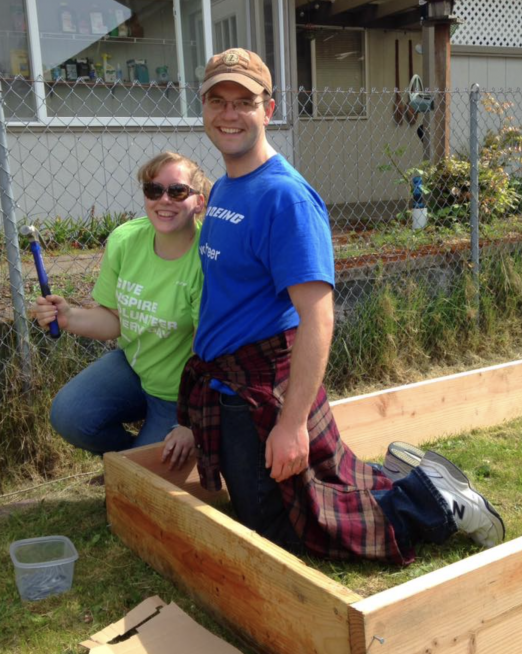


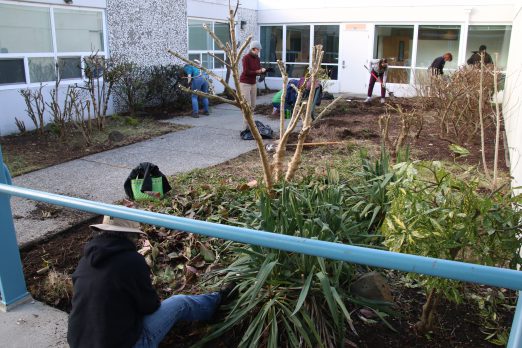
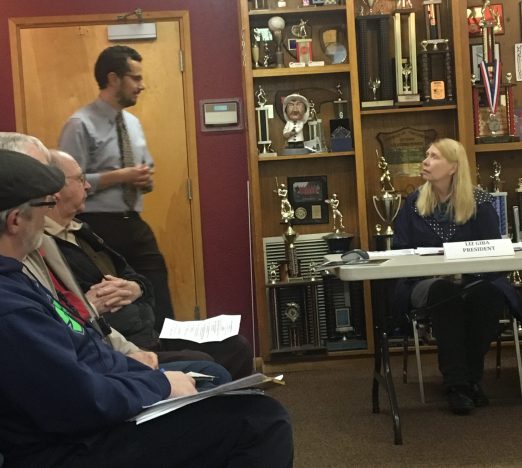





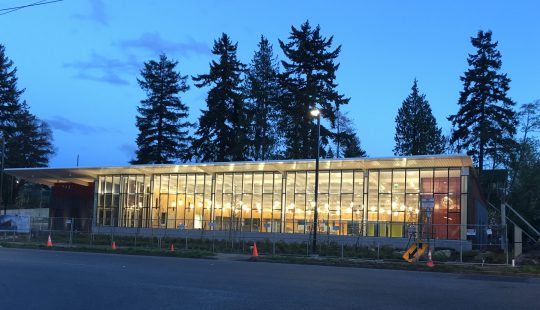
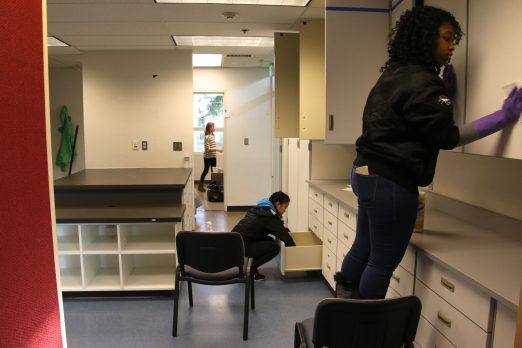
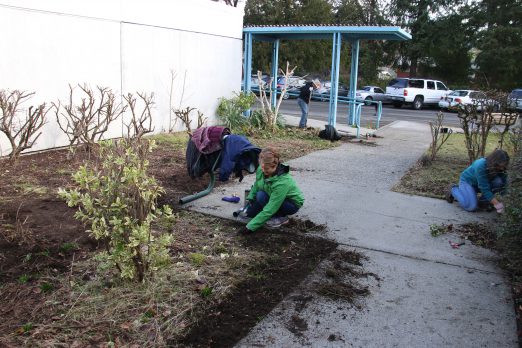
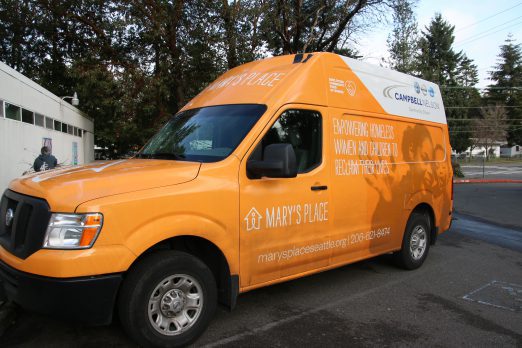
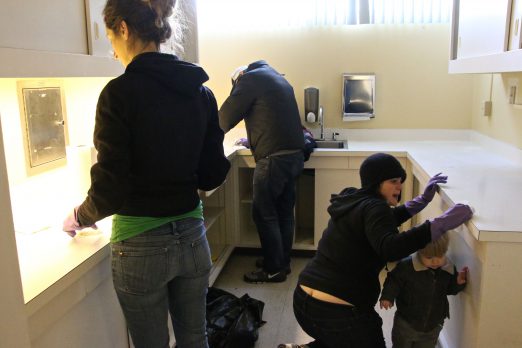

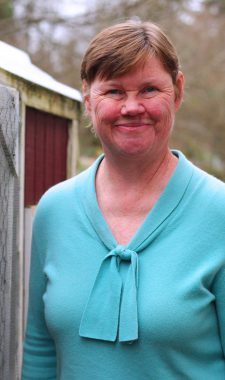 After over 9 years of rewarding work with the White Center Food Bank, Operations Manager Audrey Zemke will be leaving. Her last day is February 17.
After over 9 years of rewarding work with the White Center Food Bank, Operations Manager Audrey Zemke will be leaving. Her last day is February 17.





